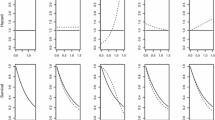Abstract
In randomized clinical trials, a treatment effect on a time-to-event endpoint is often estimated by the Cox proportional hazards model. The maximum partial likelihood estimator does not make sense if the proportional hazard assumption is violated. Xu and O’Quigley (Biostatistics 1:423–439, 2000) proposed an estimating equation, which provides an interpretable estimator for the treatment effect under model misspecification. Namely it provides a consistent estimator for the log-hazard ratio among the treatment groups if the model is correctly specified, and it is interpreted as an average log-hazard ratio over time even if misspecified. However, the method requires the assumption that censoring is independent of treatment group, which is more restricted than that for the maximum partial likelihood estimator and is often violated in practice. In this paper, we propose an alternative estimating equation. Our method provides an estimator of the same property as that of Xu and O’Quigley under the usual assumption for the maximum partial likelihood estimation. We show that our estimator is consistent and asymptotically normal, and derive a consistent estimator of the asymptotic variance. If the proportional hazards assumption holds, the efficiency of the estimator can be improved by applying the covariate adjustment method based on the semiparametric theory proposed by Lu and Tsiatis (Biometrika 95:679–694, 2008).
Similar content being viewed by others
References
Bennett S (1983) Analysis of survival data by the proportional odds model. Stat Med 2: 273–277
Committee for Proprietary Medicinal Products (CPMP): (2003) Points to consider on adjustment for baseline covariates. Stat Med 23: 701–709
Cox DR (1972) Regression models and life tables (with discussion). J R Stat Soc B 34: 187–220
DiRienzo AG, Lagakos SW (2001) Effects of model misspecification on tests of no randomized treatment effect arising from Cox’s proportional hazards model. J R Stat Soc B 63: 745–757
Gill RD, Schumacher M (1987) A simple test of the proportional hazards assumption. Biometrika 74: 289–300
Fleming TR, Harrington D (1991) Counting processes and survival analysis. Wiley, New York
Kong FH, Slud E (1997) Robust covariate-adjusted log-rank tests. Biometrika 84: 847–862
Lin DY, Wei LJ (1989) The robust inference for the Cox proportional hazards model. J Am Stat Assoc 84: 1074–1078
Lin DY, Wei LJ, Ying Z (1993) Checking the Cox model with cumulative sums of martingale-based residuals. Biometrika 80: 557–572
Lin DY, Wei LJ, Yang I, Ying Z (2000) Semiparametric regression for the mean and rate functions of recurrent events. J R Stat Soc B 62: 711–730
Lu X, Tsiatis AA (2008) Improving the efficiency of the log-rank test using auxiliary covariates. Biometrika 95: 679–694
Pettitt AN (1984) Proportional odds model for survival data and estimates using ranks. J R Stat Soc C 33: 169–175
Pollard D (1990) Empirical processes: theory and applications. Institute of Mathematical Statistics, Hayward
Struthers CA, Kalbfleisch JD (1986) Misspecified proportional hazard models. Biometrika 73: 363–369
Therneau TM, Grambsch PM (2000) Modeling survival data. Springer, New York
Tsiatis AA (2006) Semiparametric theory and missing data. Springer, New York
Tsiatis AA, Rosner GL, Tritchler DL (1985) Group sequential tests with censored survival data adjusting for covariates. Biometrika 72: 365–373
Xu R, Harrington DP (2001) A semiparametric estimate of treatment effects with censored data. Biometrics 57: 875–885
Xu R, O’Quigley J (2000) Estimating average regression effect under non-proportional hazards. Biostatistics 1: 423–439
Author information
Authors and Affiliations
Corresponding author
Rights and permissions
About this article
Cite this article
Hattori, S., Henmi, M. Estimation of treatment effects based on possibly misspecified Cox regression. Lifetime Data Anal 18, 408–433 (2012). https://doi.org/10.1007/s10985-012-9222-8
Received:
Accepted:
Published:
Issue Date:
DOI: https://doi.org/10.1007/s10985-012-9222-8




